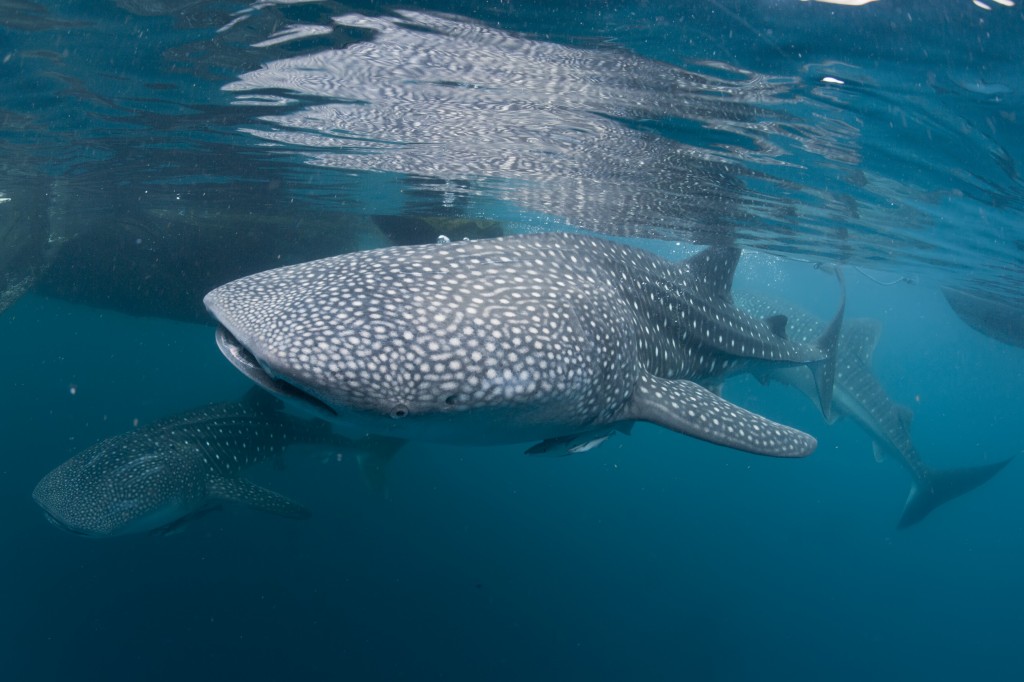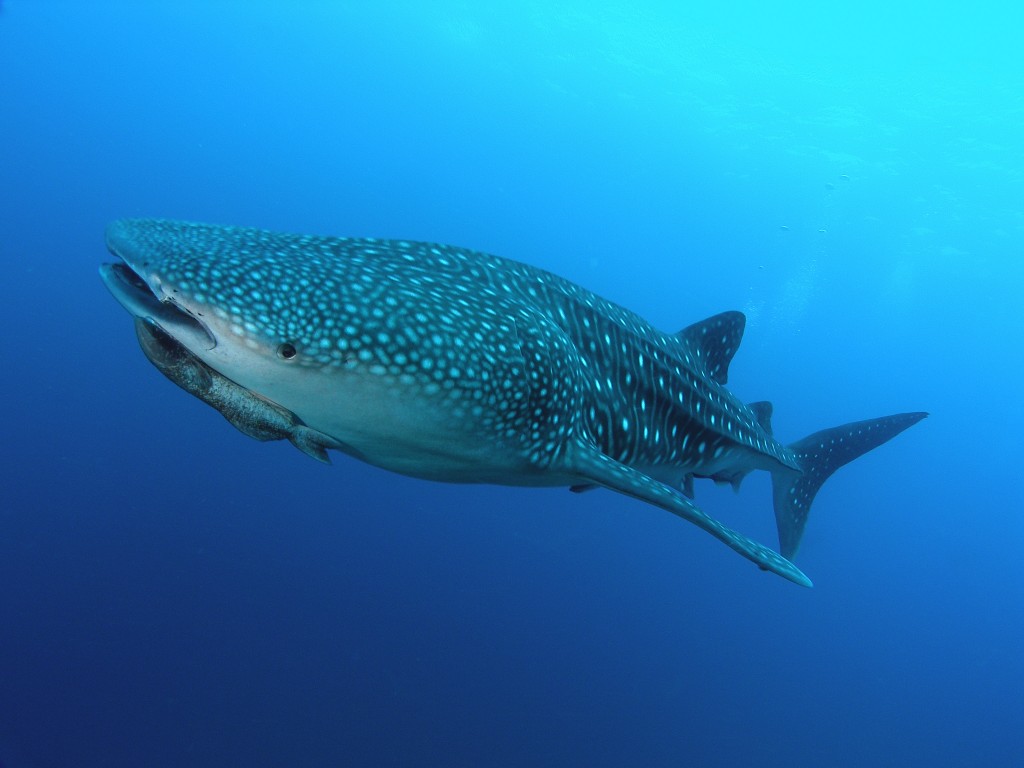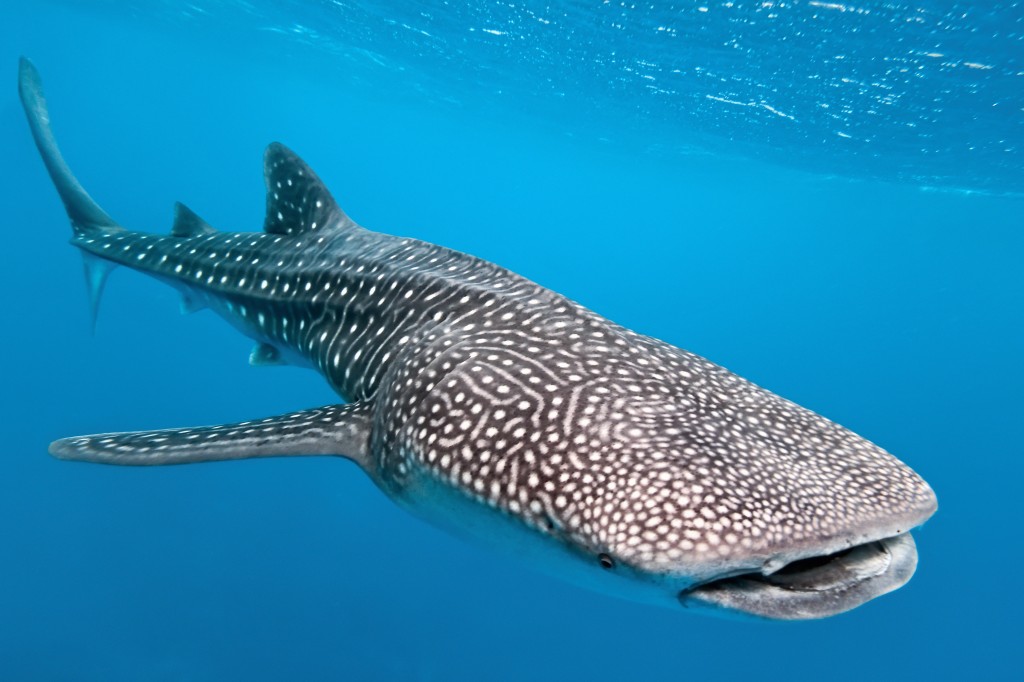The whale shark, Rhincodon typus, is the largest living Chondrichthye, or cartilaginous fish, in the world. The largest confirmed specimen was over 40 feet long. These animals can live for over 60 years, and possibly as long as 150 years. Whale sharks are filter feeders, using their large mouths and gills to collect massive quantities of smaller fish and plankton to fuel their large size. Whale sharks feed primarily on zooplankton. They also feed on shrimp, small reef fish, small pelagic fish, small squid, jellyfish, crab larvae and the gametes of reef fishes.
Whale shark life stages
With such small prey, it takes a long time for a whale shark to reach its full length and sexual maturity. Long-term research studies on whale sharks are sparse, but they estimate that whale sharks reach maturity between the ages of 9 and 21. They reach sexual maturity between the ages of 21 and 63. The large range in age estimations is due to the inconclusive ultimate size of a mature whale shark. Some scientists estimate their maximum size to be around 40 feet, while others estimate that they could reach 65 feet.
Whale shark gestation
Whale sharks are ovoviviparous, meaning the females carry live young internally after they hatch from eggs inside her body. A female whale shark can commonly carries over 300 embryos. A whale shark only faces natural predators as a juvenile; orcas, blue marlins and blue sharks have all prey on them. Divers and scientists have seen adult whale sharks with scars from possible attacks during their youth. After reaching maturity, the only threat to whale sharks is man.
Whale shark habitat
Whale sharks prefer the warm waters of the tropics, and have been spotted in the Atlantic Ocean, West Indian and the central Pacific Ocean. They migrate on an equatorial path, ranging from 30 degrees north to 35 degrees south, occasionally traveling as far as 41 degrees north and 36.5 degrees south. These animals live in the first 656 feet of the water column, in the epipelagic zone.
Human threats to whale sharks
Man has found the whale shark useful for two things: food and tourism. Called the “tofu shark” because of the white color of its meat, many Asian cultures consider the shark a delicacy. Hunting of these animals is a brutal process. Fishermen harpoon whale sharks in the open ocean, thrusting large hooks into the shark’s back. Once they hook the shark, the fishermen cut a hole in its upper and lower jaw, threading a rope through the openings so they can tow the animal to shore. The whale shark will remain in shallow waters, buoyed by its threaded jaw, and wait while negotiations are made for its slaughter. This can take several days.
Wholesale slaughter
Japan, Singapore, Hong Kong, Spain, Taiwan, the Philippines and China all sell whale-shark meat and products. Taiwan and the Philippines were the most notorious fishers of whale sharks until a slaughterhouse was discovered in China. In early 2014, after a 4-year investigation, a conservation group from Hong Kong focused the world’s spotlight on this operation, which is responsible for slaughtering 600 whale sharks a year. The factory produced items for shark-oil supplements, beauty products, shark-fin soup and leather.
What is a whale shark worth?
Whale sharks sell for approximately $11.80 per kilogram. The average whale shark weighs 10 tons, but only 45 percent of the animal is classified as meat. The approximate worth of this meat is $50,000. The whale shark’s fin fetches an additional $57,000, bringing the total price of a whale shark to a little over $100,000. This number only represents the price when a shark is sold to consumers. Fishermen earn considerably less, with one Indian fisherman reportedly being paid $4,000 for a whale shark. The average reported rate for fishermen in Taiwan is 10 cents per kilogram.
Conservation status
During the 20th century, up to 1,000 whale sharks were captured yearly in the waters off India. The excessive hunting rate quickly wreaked havoc on populations, and there was a 40 percent reduction in their capture in India by 2000. That same year, whale sharks appeared on the IUCN (International Union for Conservation of Nature) Red List of vulnerable species. In 2001, the Indian government banned whale-shark fishing. The Taiwanese government followed suit in 2007, banning the capture of whale sharks.
There are no estimates on the numbers of whale sharks remaining in the wild. However, based on decreased capture numbers, whether intentionally or as bycatch, that number is low. The captured animals are much smaller than their counterparts from the 1990s, demonstrating a shift in a population once comprised of adults and juveniles to one primarily comprised of juveniles. This means that even with the best conservation efforts in place, it will be several decades before there’s a noticeable increase in the whale shark population.
Shark tourism
With bans in place to prevent their legal capture, a new industry has been born from whale sharks: tourism. Adventurists pay big money to swim, snorkel and scuba dive with these animals. Not only is increased tourism raising awareness for these animals, but it is also bringing financial gains to the countries that sponsor such activities. Researchers estimate between 200 and 400 animals visit Australia’s Ningaloo Marine Park annually. Money from tourism means that each whale shark, over its lifetime, will generate over $300,000. A slaughtered whale shark would bring in only one-third this amount.
Although whale sharks are of monetary worth to the economies of many countries, they are even more important to the ocean health. Whale sharks directly impact a coral reef’s health. Returning to Australia’s Ningaloo Marine Park, where nearly 100,000 kilograms of tropical fish are extracted yearly, there is a direct correlation between the presence of whale sharks and coral-reef health.
Falling populations and a struggling ecosystem
As the number of reef fish falls, there is an increase in Drupella cornus, a gastropod that causes damage to reefs. Whale sharks feed on this gastropod, decreasing their population. When the population of whale sharks fell, the health of the coral reef declined as more Drupella cornus appeared. Whale sharks also feed on two siphonostomatoida copepods that can negatively affect the reef environment: Prosaetes rhinodontis, a suspected parasite, and Pandarus rhinocodonicus, which feeds on the bacteria located on the skin of marine animals.
A whale shark’s size will not necessarily protect it from man’s predation. As awareness of their importance is spreads, governments are enacting laws and hunting bans to protect them. Many areas have begun to realize a live whale shark’s value over a dead one. The economies of smaller countries are counting on this continued trend. The immediate future of whale sharks is looking up. But in the long term, it is too soon to tell if the damage done in the last century is too great to correct and whether or not these animals will one day become extinct.
By Christina Albright-Mundy




